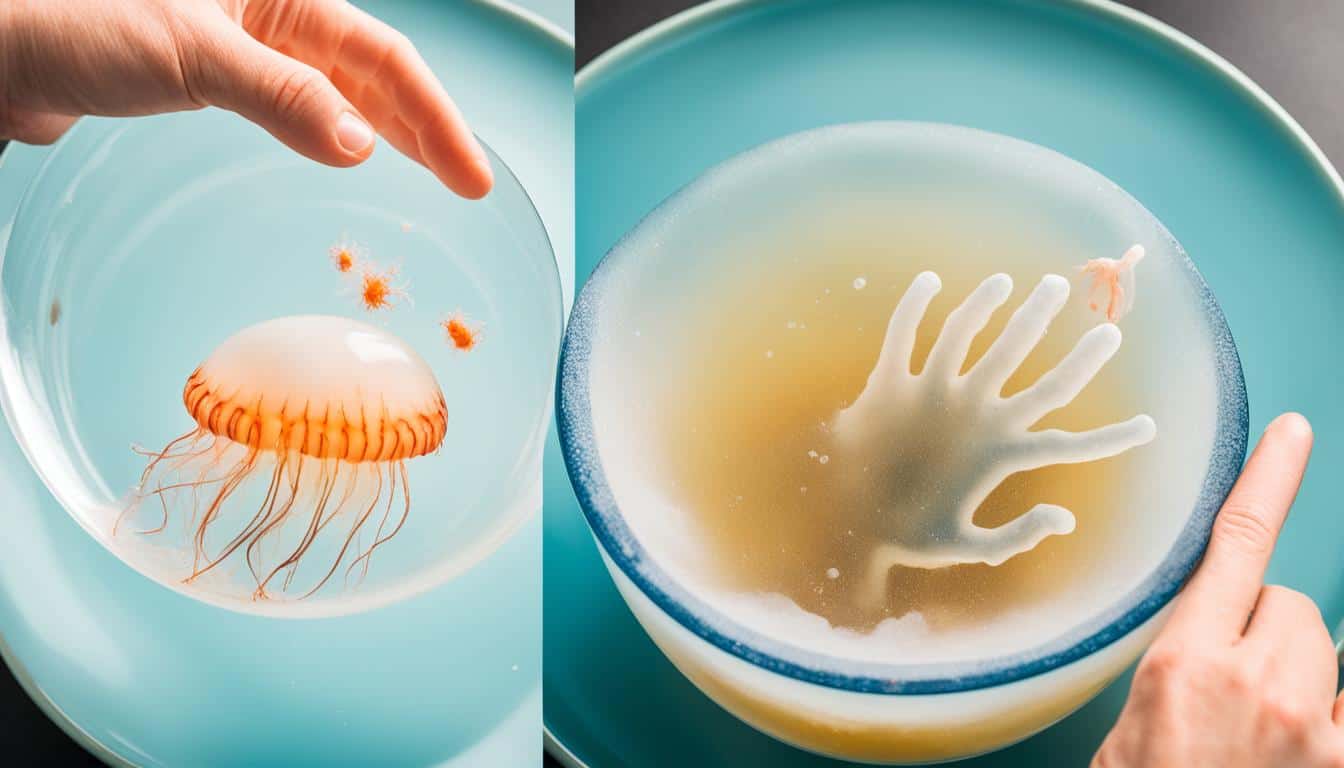Getting stung by a jellyfish can be scary, but knowing how to treat it can make things better. This article will teach you how to handle a jellyfish sting. You’ll learn about symptoms, first aid, and when to get medical help. We’ll cover the use of vinegar and hot water for relief, and when you should see a doctor. With these tips, you can safely enjoy the water again.
Understanding Jellyfish Stings
Jellyfish stings might seem minor but can have big effects on humans. Knowing what causes them helps you handle encounters better. It’s also key to know the symptoms to act fast.
What Causes Jellyfish Stings?
Jellyfish have special stinging cells called nematocysts in their tentacles. These cells release venom when they touch skin. You might get stung while swimming or wading in their habitat. The type of jellyfish affects how bad the sting is, from mild to serious.
Common Symptoms of a Jellyfish Sting
Knowing the signs of a jellyfish sting is important for quick treatment. Look out for:
- Pain at the sting site
- Redness and inflammation
- Intense itching
- Swelling
With very dangerous jellyfish like the box jellyfish, symptoms can get worse. They might include severe skin issues, trouble breathing, and even heart problems. Knowing these facts can help keep you safe in the ocean.
How Can You Treat a Jellyfish Sting?
If you get a jellyfish sting, acting fast is key. Knowing how to handle it can lessen the pain and stop more problems. Here are the steps for treating a jellyfish sting and what to do after.
Immediate First Aid Steps
First, get the person out of the water to stop more stings. Here are the key steps for treating a jellyfish sting right away:
- Rinse the affected area with vinegar for at least 30 seconds to neutralize stinging cells and prevent them from firing.
- Avoid using fresh water, as this may aggravate the sting further.
- Use tweezers to gently remove any visible tentacles without scraping the skin.
- Apply heat to the sting site, as it can help alleviate pain.
Precautions to Take After a Sting
After first aid, watch the person closely. Look out for signs of serious reactions, such as:
- Difficulty breathing
- Swelling around the sting site or the face
- Signs of an allergic reaction such as hives or dizziness
If you see any of these signs, get medical help right away. Knowing what to do if you’re stung by a jellyfish can really help you recover.
First Aid for Jellyfish Stings
Quick action is key when dealing with jellyfish stings. It helps reduce pain and prevents more problems. Here are steps to follow for your safety and comfort.
Removing Tentacles Safely
First, remove the jellyfish tentacles safely. Use tweezers with fine tips to pull out any visible tentacles. Don’t use your hands to avoid getting more stung. Also, don’t scrape the skin as it can make things worse.
Make sure to take your time and remove all tentacles carefully.
Recommended Techniques for Pain Relief
To ease the pain, put the affected area in hot water. The ideal temperature is between 110 to 113°F. This can help reduce the discomfort for 20 to 45 minutes.
Also, you can use hydrocortisone cream to lessen inflammation and itching. But, avoid using things like meat tenderizer, alcohol, or ice. These may not help and could make things worse.
The Role of Vinegar in Jellyfish Sting Treatment
Vinegar is a key tool for treating jellyfish stings, especially from dangerous ones like the box jellyfish. It has special properties that lessen the sting’s effects and discomfort.
How Vinegar Helps to Neutralize Venom
Vinegar’s acidity can neutralize the jellyfish venom. This stops the stinging cells from firing again after they’re triggered. Studies show that vinegar can cut down on pain and irritation from stings.
Application Methods and Safety Tips
For best results, apply vinegar correctly:
- Rinse the sting site with vinegar for at least 30 seconds.
- Use a container to make sure vinegar touches the affected area.
- Keep vinegar handy at beaches where jellyfish are common.
- Avoid using fresh water, as it might make the sting worse.
- Watch for signs of an allergic reaction after using vinegar.

These tips show how important vinegar is in treating jellyfish stings. Using these methods can make beach trips safer and more enjoyable.
Hot Water as a Treatment Method
Hot water can help ease the pain of a jellyfish sting. By soaking the affected area in warm water, you can stop the pain and help it heal. It’s important to know the benefits of hot water immersion and how to prepare it right for relief.
Benefits of Hot Water Immersion
Hot water immersion has many advantages for jellyfish sting victims:
- Immediate pain relief: The warmth can ease the sting’s pain.
- Inactivation of toxins: Heat breaks down the venom, reducing its effects.
- Reduction of muscle spasms: Warmth helps relax muscles tightened by the sting.
- Enhanced blood circulation: Hot water increases blood flow, aiding healing.
How to Prepare the Right Temperature
Getting the water temperature right is key for safe and effective treatment. Here’s what to do:
- Heat water to a temperature between 110°F to 113°F. Use a thermometer for accuracy.
- Soak the affected area in the warm water for 20 to 45 minutes. Watch for swelling or severe reactions.
- Keep an eye on the water temperature to avoid burns. Make sure it stays hot but not too hot.
When to Seek Medical Attention for a Jellyfish Sting
Knowing when a jellyfish sting needs medical help is key to staying safe. Most stings can be treated at home, but some need quick action. Watch out for signs like trouble breathing, big swelling of the tongue or lips, or a rash all over. These could mean a serious allergic reaction and you should get help right away.
Signs of Severe Reactions
It’s important to know when you need help for a jellyfish sting. Look out for chest pain, feeling sick, or a lot of pain that goes beyond where you got stung. These could be signs of a serious issue. Especially, if you’re stung by a very venomous jellyfish like a box jellyfish, you need fast treatment to avoid danger.
Emergency Treatments for Dangerous Jellyfish Stings
For a jellyfish sting, emergency care might include CPR if the person is not awake. Some stings might need antivenom, especially from the most dangerous jellyfish. If you’re not sure how bad your symptoms are, always talk to a doctor. Getting medical help quickly can really help if you get stung by a jellyfish.
FAQ
How can you treat a jellyfish sting effectively?
To treat a jellyfish sting, first remove the person from the water. Then, rinse the sting site with vinegar to stop more sting cells from activating. Use fine-tipped tweezers to remove any visible tentacles.
Next, soak the affected area in hot water between 110 to 113 F for 20 to 45 minutes. This helps with pain relief.
What immediate first aid steps should be taken after a jellyfish sting?
First, get yourself or the person out of the water. Rinse the area with vinegar, not fresh water. Use tweezers to carefully remove any tentacles.
Watch for signs of severe reactions like trouble breathing or swelling.
What are the common symptoms of a jellyfish sting?
Common symptoms include pain, redness, itching, and swelling where the sting happened. In severe cases, like with dangerous jellyfish, symptoms can include trouble breathing and a lot of swelling.
How does vinegar help treat jellyfish stings?
Vinegar helps by neutralizing the venom, especially from box jellyfish. Its acid stops the nematocysts from firing. This reduces pain and prevents further damage.
What are the recommended techniques for pain relief from a jellyfish sting?
For pain relief, soak the sting in hot water (110 to 113 F) for 20 to 45 minutes. Use hydrocortisone cream for swelling. But avoid using ice or alcohol, as they can make things worse.
When should I seek medical attention for a jellyfish sting?
If you see signs of severe reactions, get medical help. This includes trouble breathing, big swelling of the tongue or lips, or a widespread rash. Some jellyfish stings need emergency treatment.
What should I avoid doing if stung by a jellyfish?
Avoid rinsing with fresh water, as it can make things worse. Don’t scrape off tentacles. Use tweezers to remove them safely. Also, don’t try unproven remedies like meat tenderizer or alcohol.
What is the best way to monitor for severe reactions after a jellyfish sting?
Keep an eye on the person for signs like trouble breathing, swelling in the face or throat, and changes in how awake or alert they are. If you see these signs, get medical help right away.
How can I prepare hot water for treating a jellyfish sting?
To prepare hot water, heat it to 110 to 113 F. Use a thermometer to make sure it’s safe. Soak the affected area for 20 to 45 minutes. Always be careful to avoid burns.







